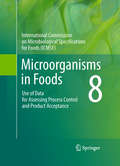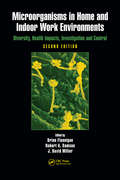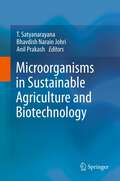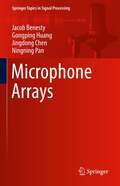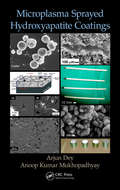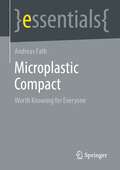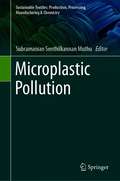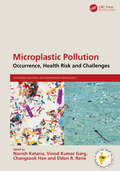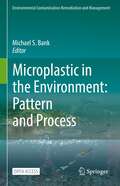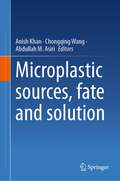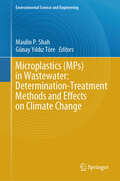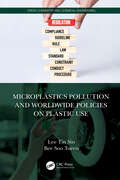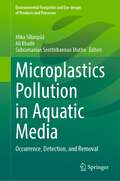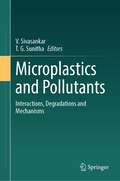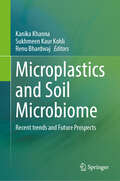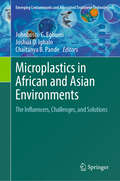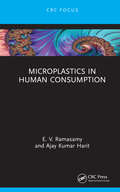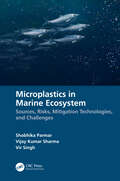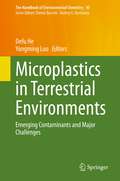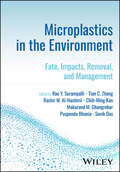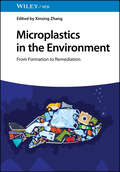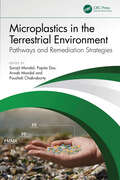- Table View
- List View
Microorganisms in Foods 8
by International Commission on Microbiological Specifications for FoodsMicroorganisms in Foods 8: Use of Data for Assessing Process Control and Product Acceptance is written by the International Commission on Microbiological Specifications for Foods with assistance from a limited number of consultants. The purpose of this book is to provide guidance on appropriate testing of food processing environments, processing lines, and finished product to enhance the safety and microbiological quality of the food supply. Microorganisms in Foods 8 consists of two parts. Part I, Principles of Using Data in Microbial Control, builds on the principles of Microorganisms in Foods 7: Microbiological Testing in Food Safety Management (2002), which illustrates how HACCP and Good Hygienic Practices (GHP) provide greater assurance of safety than microbiological testing, but also identifies circumstances where microbiological testing may play a useful role. Part II, Specific Applications to Commodities, provides practical examples of criteria and other tests and is an updated and expanded version of Part II of Microorganisms in Foods 2: Sampling for Microbiological Analysis: Principles and Specific Applications (2nd ed. 1986). Part II also builds on the 2nd edition of Microorganisms in Foods 6: Microbial Ecology of Food Commodities (2005) by identifying appropriate tests to evaluation the effectiveness of controls.
Microorganisms in Home and Indoor Work Environments: Diversity, Health Impacts, Investigation and Control, Second Edition
by J. David Miller Robert A. Samson Brian FlanniganIn 2007, scientists estimated the direct cost of diseases associated with mould and dampness on the US population to be in the range of 4 billion dollars, and the indirect costs of lost work and school days are gauged even higher. The US Centers for Disease Control recently concluded that elimination of moisture and mouldy materials in the home def
Microorganisms in Sustainable Agriculture and Biotechnology
by Bhavdish Narain Johri Anil Prakash T. SatyanarayanaThis review of recent developments in our understanding of the role of microbes in sustainable agriculture and biotechnology covers a research area with enormous untapped potential. Chemical fertilizers, pesticides, herbicides and other agricultural inputs derived from fossil fuels have increased agricultural production, yet growing awareness and concern over their adverse effects on soil productivity and environmental quality cannot be ignored. The high cost of these products, the difficulties of meeting demand for them, and their harmful environmental legacy have encouraged scientists to develop alternative strategies to raise productivity, with microbes playing a central role in these efforts. One application is the use of soil microbes as bioinoculants for supplying nutrients and/or stimulating plant growth. Some rhizospheric microbes are known to synthesize plant growth-promoters, siderophores and antibiotics, as well as aiding phosphorous uptake. The last 40 years have seen rapid strides made in our appreciation of the diversity of environmental microbes and their possible benefits to sustainable agriculture and production. The advent of powerful new methodologies in microbial genetics, molecular biology and biotechnology has only quickened the pace of developments. The vital part played by microbes in sustaining our planet's ecosystems only adds urgency to this enquiry. Culture-dependent microbes already contribute much to human life, yet the latent potential of vast numbers of uncultured--and thus untouched--microbes, is enormous. Culture-independent metagenomic approaches employed in a variety of natural habitats have alerted us to the sheer diversity of these microbes, and resulted in the characterization of novel genes and gene products. Several new antibiotics and biocatalysts have been discovered among environmental genomes and some products have already been commercialized. Meanwhile, dozens of industrial products currently formulated in large quantities from petrochemicals, such as ethanol, butanol, organic acids, and amino acids, are equally obtainable through microbial fermentation. Edited by a trio of recognized authorities on the subject, this survey of a fast-moving field--with so many benefits within reach--will be required reading for all those investigating ways to harness the power of microorganisms in making both agriculture and biotechnology more sustainable.
Microparticle Dynamics in Electrostatic and Flow Fields (Springer Theses)
by Sheng ChenThis thesis proposes new approaches for modelling contacting interactions and electrostatic interactions between microparticles in the framework of the discrete element method and presents a systematic investigation on the agglomeration, migration and deposition of microparticles in presence of electrostatic and flow fields. It reports an exponential-form scaling for the size distribution of early-stage agglomerates in homogeneous isotropic turbulence and formulate the agglomeration and deagglomeration rates. The evolution of spherical clouds of charged particles that migrate under the action of an external electrostatic field is then investigated. Scaling laws of cloud radius and particle number density are obtained by solving a continuum convection equation. Finally, it investigates the deposition of charged particles on a flat plane and fibers. A dimensionless adhesion parameter is constructed to predict the structure of deposits. The temporal evolution of the deposit structure, particle capture efficiency, and the pressure drop are displayed with varying values of Coulomb repulsion and adhesion magnitudes.
Microphone Arrays (Springer Topics in Signal Processing #22)
by Jacob Benesty Jingdong Chen Gongping Huang Ningning PanThis book explains the motivation for using microphone arrays as opposed to using a single sensor for sound acquisition. The book then goes on to summarize the most useful ideas, concepts, results, and new algorithms therein. The material presented in this work includes analysis of the advantages of using microphone arrays, including dimensionality reduction to remove the redundancy while preserving the variability of the array signals using the principal component analysis (PCA). The authors also discuss benefits such as beamforming with low-rank approximations, fixed, adaptive, and robust distortionless beamforming, differential beamforming, and a new form of binaural beamforming that takes advantage of both beamforming and human binaural hearing properties to improve speech intelligibility. The book makes the microphone array signal processing theory and applications available in a complete and self-contained text. The authors attempt to explain the main ideas in a clear and rigorous way so that the reader can easily capture the potentials, opportunities, challenges, and limitations of microphone array signal processing. This book is written for those who work on the topics of microphone arrays, noise reduction, speech enhancement, speech communication, and human-machine speech interfaces.
Microplasma Sprayed Hydroxyapatite Coatings
by Arjun Dey Anoop Kumar MukhopadhyayThere has been enormous growth in the use of medical implants. However, in the case of hip replacement, loosening of metallic prosthesis fixed with polymethylmethylacrylate bone cement has resulted in painstaking revision surgery, which is a major problem for the patient, surgeon, and biomedical technology itself. In fact, global recognition of thi
Microplastic Compact: Worth Knowing for Everyone (essentials)
by Andreas FathWill we suffocate in our own plastic waste in the coming years? Or will we manage to turn the corner in time? The constantly growing amount of plastic waste is problematic for the environment and for people who consume the plastic waste in the form of microplastics. The author Andreas Fath explains in a scientifically well-founded but generally understandable way what microplastics are, where they come from and what dangers they pose.The translation was done with the help of artificial intelligence (machine translation by the serviceDeepL.com). A subsequent human revision was done primarily in terms of content.
Microplastic Pollution (Sustainable Textiles: Production, Processing, Manufacturing & Chemistry)
by Subramanian Senthilkannan MuthuThis book addresses the emergent need to act on reducing or getting rid of micro plastic pollution, to achieve a sustainable environment. Microplastics are small plastic pieces, which are less than five millimeters long which can be harmful to our oceans and aquatic life. These predominantly include microfibers from clothing, microbeads, and plastic pellets. Microplastics impact aquatic creatures, turtles and birds. According to the first study on estimation of human ingestion of microplastic, on average a person consumes at least 50,000 particles of microplastic a year and breathes a similar quantity. Ingested microplastic particles can physically damage organs and also compromise immune function and stymie growth and reproduction. This book presents six informative chapters in order to alleviate the above mentioned issues.
Microplastic Pollution: Occurrence, Health Risk and Challenges (Sustainable Industrial and Environmental Bioprocesses)
by Eldon R. Rene Vinod Kumar Garg Navish Kataria Changseok HanThis reference book reviews various aspects of microplastics, from their sources and manifestation in terrestrial, aquatic, and air environments to their fate in wastewater treatment systems. It also covers sampling, analysis, and detection methods for microplastics, along with advanced instrumentation for quantification. Further, the book presents health risk analysis and the toxicity of microplastic contamination, including their ecotoxicological impact on the environment and health risks associated with their accumulation in the tropical food chain and food web. The chapters also present studies exploring the health risks associated with microplastic additives and their interactions with other pollutants. The final chapters focus on plastic and microplastics management, exploring advanced technologies for bioplastics production, the biodegradation of plastics and bioplastics, and the role of nanotechnology in plastic management. This book serves as an important source for researchers, policymakers, and environmentalists concerned about the impact of microplastics on ecosystems and human health.
Microplastic in the Environment: Pattern and Process (Environmental Contamination Remediation and Management)
by Michael S. BankThis open access book examines global plastic pollution, an issue that has become a critical societal challenge with implications for environmental and public health. This volume provides a comprehensive, holistic analysis on the plastic cycle and its subsequent effects on biota, food security, and human exposure. Importantly, global environmental change and its associated, systems-level processes, including atmospheric deposition, ecosystem complexity, UV exposure, wind patterns, water stratification, ocean circulation, etc., are all important direct and indirect factors governing the fate, transport and biotic and abiotic processing of plastic particles across ecosystem types. Furthermore, the distribution of plastic in the ocean is not independent of terrestrial ecosystem dynamics, since much of the plastic in marine ecosystems originates from land and should therefore be evaluated in the context of the larger plastic cycle. Changes in species size, distribution, habitat, and food web complexity, due to global environmental change, will likely alter trophic transfer dynamics and the ecological effects of nano- and microplastics. The fate and transport dynamics of plastic particles are influenced by their size, form, shape, polymer type, additives, and overall ecosystem conditions. In addition to the risks that plastics pose to the total environment, the potential impacts on human health and exposure routes, including seafood consumption, and air and drinking water need to be assessed in a comprehensive and quantitative manner. Here I present a holistic and interdisciplinary book volume designed to advance the understanding of plastic cycling in the environment with an emphasis on sources, fate and transport, ecotoxicology, climate change effects, food security, microbiology, sustainability, human exposure and public policy.
Microplastic sources, fate and solution
by Abdullah M. Asiri Anish Khan Chongqing WangThis book provides an overview of the sources, occurrence, fate and solution of microplastics. Microplastics in sediment and soil environment have been only scarcely surveyed, and no profound discussion on microplastics removal is summarized until this book. Here we focus on sharing clear schematic information and the book sufficiently supports important microplastic topics: such as microbial network, microplastic toxicology and accumulation, agricultural plastics, nylon microplastics, polystyrene microplastics, polyethylene microplastics and many more. The book mainly provides an overview of recent advances in knowledge of sources, occurrence, distribution, chemical behavior and ecological threats while it also presents information related to feasible solutions for microplastic pollution management. This comprehensive resource will be valuable up-to-date knowledge for environmental scientists, ecotoxicologists, ecologists, marine biologists, environmental chemists in the academic field and this book is intended to be beneficial information for environmental managers, water suppliers, wastewater treatment, plastics manufacturer, and policy makers as well.
Microplastic: Distribution, Avoidance, Usage
by Andreas FathThe book presents the entire spectrum of the microplastics problem in our waters, from the collection of water samples to their analysis and interpretation. As part of the "R(h)eines Wasser" project, the author swam the Rhine and, based on this experience, addresses a sensitive issue that will occupy humanity for many years to come.
Microplastics (Environmental Science and Engineering)
by Maulin P. Shah Günay Yıldız TöreThis book systematically summarizes the occurrence and source of MPs through various municipal and industrial wastewaters. It covers the type of MPs, its effects on human health and climate, and emerging detection and treatment methods. Plastics are one of the refractory pollutants produced in many and varied forms using chemistry and materials science. Microplastics (MPs), which are formed as a result of plastics breaking down into small pieces, are a new indicator that indicates that the plastic footprint of humans is growing today and this has become a risk for the general living health and sustainable environment. Depending on the point of use, they are either directly released to the air, water, and soil, or they break down into secondary MPs in the environment where they are discharged. Especially by means of domestic wastewater, plenty of MPs enter the sewage system on a daily basis. Therefore, wastewater treatment plants (WWTPs) draw attention as an important source of MP pollution in coastal or surface waters such as sea, lake, and river. There is still a limited number of studies on MPs in the literature and it has become the focus of many researchers around the world. This book mainly focuses on the behavior of microplastics in the wastewaters. The book has 12 chapters and throughout each chapter, it presents the fate and effect of MPs, quantitative and qualitative analyses of MPs in wastewaters and treatment of MPs through conventional and advanced wastewater treatment technologies, effects of MPs on human health and climate change and also evaluates the legal restrictions for MPs pollution in the environment and will also be examined in all details. It also boosts the knowledge of students, researchers, scientists, professors, engineer, and professionals who aspire to work in the field of environmental science, environmental biotechnology, environmental microbiology, civil/environmental engineering, eco-toxicology and other relevant areas of wastewater treatment and management for the safety of environment. In addition to this, the readers of the book can also get the valuable information about the various environmental problems-related climate change and their solutions.
Microplastics Pollution Control in Water Systems: Practical Solutions
by Javid Ahmad Parray A. K. Haghi Nowsheen Shameem Aparna B. GunjalThis book covers advanced solutions for managing water systems pollution caused by microplastics. It provides a comprehensive overview of microplastic contamination, spanning detection in municipal water systems, removal from wastewater using sustainable technologies, and monitoring methods in natural environments. The book also discusses the impacts of microplastics on water bodies and the limitations of current treatment processes, presenting complementary methods to address microplastic contamination. In this book, particular attention is given to practical insights into dealing with microplastic pollution, and readers will find several case studies such as the application of nonwoven electrospun nano-membranes and activated carbon adsorbents for microplastics removal, alongside novel laboratory experiments and field methods like the invertebrate kick-netting technique. The book also offers a forward-looking approach, discussing cutting-edge topics like the application of artificial intelligence for microplastic identification, and the impact of land use patterns on soil microplastic pollution. The book concludes with a chapter devoted to smart management solutions, providing a glimpse into future trends and perspectives in the field. Given its breadth and coverage, the book appeals not only to academics and researchers in the fields of environmental chemistry and environmental sciences but also to professionals and policymakers dealing with microplastic pollution and research.
Microplastics Pollution and Worldwide Policies on Plastic Use (ISSN)
by Tin Sin Lee Soo Tueen BeeMicroplastics Pollution and Worldwide Policies on Plastic Use discusses microplastic pollution and global policies developed to tackle the problem. It details the mechanisms of microplastics occurrence, sources, and impacts. It then offers a comprehensive overview of the various policies created by specific countries in Asia, Europe, the Americas, and Africa to address plastics use and minimize its effects. Describes microplastics pollution found worldwide in drinking water and food chains. Addresses policies implemented in Asia, Europe, the Americas, and Africa and details local policies for various countries within each region, including requirements and penalties for non-compliance. Explains the mission and vision of global organizations such as the United Nations, G7, World Economic Forum, World Bank, and Lisbon Treaty. This book is aimed at academics, industrial professionals, policy makers, and general readers interested in the mitigation of microplastic pollution.
Microplastics Pollution in Aquatic Media: Occurrence, Detection, and Removal (Environmental Footprints and Eco-design of Products and Processes)
by Mika Sillanpää Subramanian Senthilkannan Muthu Ali KhadirThis book highlights one of the most important water pollutants known as Microplastics. It has been reported that humans and the environment are dealing with microplastics particles in water and aquatic media. Despite the fact that such pollution might have mainly started out from the sea, it is now in lakes, rivers, ponds and even drinking water. This book presents as overview of microplastics in freshwater environments in different regions around the world. It discusses the ecotoxicological effects of microplastics, the removal/remediation techniques of microplastics and the role of water/wastewater treatment plants in spreading microplastics. This book is a valuable resource, covering wide aspects of microplastics from sources, detection and characterization to removal and their fate in treatment plants.
Microplastics and Pollutants: Interactions, Degradations and Mechanisms
by V. Sivasankar T. G. SunithaThis volume discusses the adsorptive profiles of microplastic (MP) pollutants, covering their structural identity, sorption ability and degradation due to photolytic, hydrolytic, mechanical, and other environmental factors. In addition to the quantitation of (MPs) in the environment, the book unveils the deleterious effects on aquatic species and humans due to adsorbed inorganic/organic contaminants on the surface of MPs. The present book finds its uniqueness by presenting in-depth discussions on the interactions and mechanisms of microplastics with organic pollutants, microalgae, and human systems. The interactions and mechanisms between microplastics and microalgae are explored to understand the possible remediation pathways in microplastic contaminated water resources. Students and researchers in the fields of environmental science and engineering, biotechnology, aquaculture, marine technology, and water chemistry can benefit from this book. Furthermore, industries, NGOs and stakeholders dealing with wastewater, solid waste/environmental pollution will find this book useful.
Microplastics and Soil Microbiome: Recent trends and Future Prospects
by Renu Bhardwaj Kanika Khanna Sukhmeen Kaur KohliThis edited book is a comprehensive collection of information on microplastics and their existence within the environment. The main focus of this book is to address the ecological aspect of microplastics and their degradation of the ecosystem. It deals with the distribution, persistence, fate, and remediation of microplastics with novel strategies such as nanoparticles, beneficial microbes, biofilms, enzymatic processes, bio-nano materials, biotechnological and other sustainable approaches. The widespread presence of microplastics in the environment has led to major concerns, thereby orienting the studies on the interactions within the environment among plants and soil microbiome. The variety and properties of microplastics in the environment make their interactions more complex. The emergence of new ecological sites will also affect the ecosystem of water and soil. This title compiles updated aspects and information about the remediation practices and the fateof microplastics in the environment. The book focuses on eco-friendly, eco-efficiency and novel practices to deal with microplastic pollution. This book is of interest and useful to agricultural professionals, environmentalists, industrialists, field-level extension workers, planters, industrial entrepreneurs, ecologists, and a valuable source of reference to the relevant researchers and students in the region.
Microplastics in African and Asian Environments: The Influencers, Challenges, and Solutions (Emerging Contaminants and Associated Treatment Technologies)
by Chaitanya B. Pande Johnbosco C. Egbueri Joshua O. IghaloThis innovative book tackles the pressing global environmental issue of microplastic pollution, with a particular focus on the diverse and ecologically significant regions of Africa and Asia. Through comprehensive analysis, it unveils the alarming extent of microplastic contamination in these regions, highlighting the urgent need for attention and action. The book provides a thorough introduction to microplastics, exploring their composition, formation process, and mechanisms of infiltration into terrestrial and aquatic ecosystems. It explains their transport mechanisms, their presence in air, water, soil, sediments, wetlands, and their far-reaching ecological impacts on food security and human health. It investigates their direct and indirect effects on public health, including inhalation, ingestion, toxicological implications, and overall consequences. The book also examines the interactions between human activities, socioeconomic factors, and microplastic proliferation across different environmental compartments. Drawing insights from case studies across coastal cities and remote rural areas, the book illustrates the scope and magnitude of this problem in Africa and Asia. Furthermore, it provides an overview of analytical techniques and methodologies employed in microplastic research, such as GIS, remote sensing, spectroscopy, and computational modelling. It meticulously analyzes current mitigation techniques, best practices, policy frameworks, and the role of public awareness in addressing this issue. The book offers insights into future research directions, mitigation strategies, and broader ecological and human health aspects of microplastic pollution. Designed as a graduate-level resource, this interdisciplinary book is invaluable for researchers across disciplines, policymakers working in these regions, and anyone concerned about the pervasive issue of microplastic pollution and its far-reaching consequences across several other regions of the world.
Microplastics in Human Consumption
by E. V. Ramasamy Ajay Kumar HaritThis book highlights plastic pollution, especially microplastics, and the consequences on the environment and on the human diet through food chain/web transmission and contamination through processing and packaging of various human food items including water and beverages. This book provides a detailed outlook on the microplastics, their origin, distribution, categories, presence in human food items and their impact on the ecosystem, organisms and so forth. It covers updated information on microplastic contamination in the biotic and abiotic products of the sea/ocean, the contamination of microplastics in drinking water/bottled water, honey, sugar and so forth. Features: Discusses the presence of microplastics in matrices prone to human consumption. Includes general information on microplastics, their origin, types, shapes, size and nomenclature. Reviews microplastics in different types of human consumable items. Illustrates fundamental methods and techniques used in microplastics research. Explores overall impacts of microplastics in the organisms contaminated with the same. This book is aimed at researchers, graduate students and faculty members interested in plastic pollution, microplastics, environmental science, food consumption and analysis.
Microplastics in Marine Ecosystem: Sources, Risks, Mitigation Technologies, and Challenges
by Vijay Kumar Sharma Vir Singh Shobhika ParmarThis book addresses pertinent issues relating to microplastic pollution including its sources and sink of the microplastics and their environmental fate. It focuses on the impacts of microplastic pollution on marine life and human health. Available conventional methods and future solutions for the prevention and control of the marine microplastic pollution, such as bacterial and marine fungus biodegradation, membrane technology, and bioengineered microbes are included along with limitations and future challenges. Features: Provides detailed insight into the marine microplastics pollution, fate, health impacts, and removal technology Reviews ecological risks and environmental fate of microplastic pollution to the marine ecosystem Describes control and prevention methods of the microplastics pollution Covers global legislature for the mitigation of microplastic to the marine environment Discusses the role of community participation for the reduction of microplastic emissions This book is aimed at researchers and professionals in environmental engineering, science, and chemistry, marine pollution, marine and aquatic science.
Microplastics in Terrestrial Environments: Emerging Contaminants and Major Challenges (The Handbook of Environmental Chemistry #95)
by Yongming Luo Defu HeThis book focuses on microplastics as emerging persistent contaminants in terrestrial environments. Scientists from around the globe review recent advances in multi-disciplinary research on micro(nano)plastics, including analytical methods; the sources, fate and distribution of microplastics; ecological risks; toxicity and health risks; and control and countermeasures for microplastics in terrestrial environments. Offering a comprehensive overview of microplastics in terrestrial environments, the book is a valuable resource for environmental researchers, ecologists and toxicologists, as well as for policymakers and non-experts.
Microplastics in the Environment: Fate, Impacts, Removal, and Management
by Rao Y. Surampalli Tian C. Zhang Makarand M. Ghangrekar Chih-Ming Kao Puspendu Bhunia Sovik Das Bashir M. Al-HashimiEnables readers to assess, manage and prevent damage from the environment’s biggest enemy: microplastics Microplastics in the Environment addresses the biggest unresolved pollution issue: microplastics accumulating in the environment at a rapidly growing rate, giving rise to severe ecological stress and novel diseases in both aquatic and terrestrial organisms. This book is a one-stop resource that ties together the latest developments in this fast-moving field, including analytical techniques, risk assessment methods and predictive approaches, and evaluates different strategies that make it possible to minimize and redress microplastics pollution in the near and distant future. The book is organized into three main parts. Part one explains the fundamental ideas underlying microplastics, including their classification, major sources, detection and characterisation, as well as risk assessment methods. The second part covers the fate and transport of microplastics in various environmental domains, their interaction with ecosystems and the exposure of humans to environment-borne microplastics. The final part surveys current and future approaches to limit and remove the environmental effects of microplastics, from replacement of plastics with biodegradable substitutes to more efficient recycling of plastics to their active removal and remediation. Microplastics in the Environment includes information on: Microplastics’ interaction with agricultural crops, the food and construction industries and water and solid waste pollution control systemsMicroplastics in microbial communities, crops and soil and the subsequent impacts on microbial metabolism, plant growth and geo-chemical properties of soil, respectivelyConsumption of microplastics by aquatic life and consequent effects of microplastics on the development of aquatic organisms including corals, invertebrates and marine and freshwater biotaGlobal strategies, existing regulations and policies focused on microplastics management With its emphasis on management and remediation, Microplastics in the Environment is a valuable resource for environmental scientists, government agencies and researchers working in the field of microplastics pollution.
Microplastics in the Environment: From Formation to Remediation
by Xinxing ZhangAuthoritative reference addressing the characteristics, technologies, and solutions surrounding the most concerning environmental pollutant Microplastics in the Environment delivers a systematic and in-depth overview of microplastics generation mechanisms, risk prevention, and control solutions. Written by a highly qualified academic with significant research experience in microplastic pollution treatment, green polymer material functionalization, and recycling of solid waste, Microplastics in the Environment explores sample topics including: Characteristics of microplastics, such as their large specific surface area and small size, resulting in the formation of composite contamination New microplastics blocking approaches and technologies, and the mechanism of microplastics generation under the coupling effect of multiple environmental factors Transport and migration of microplastics, as well as their ecotoxicity to organisms in various environments, especially the complex estuarine environment The current state of plastic production, with insight on how society can find solutions to the expanding plastics industry Microplastics in the Environment is an essential reference on the subject for polymer chemists, materials scientists, environmental chemists, plastics technologists, and ecotoxicologists, as well as all professionals in the plastics industry, especially those focused on sustainability.
Microplastics in the Terrestrial Environment: Pathways and Remediation Strategies
by Surajit Mondal Papita Das Arnab Mondal Poushali ChakrabortyThis book aims to address details and research gaps in the impacts of microplastics in terrestrial ecosystems. It addresses the impact of microplastics on the soil environment, and highlights and discusses their transport behavior, pollution level, and the combined effects of the microplastics with other pollutants on the soil ecology. Furthermore, it also highlights the effects of UV irradiations and mechanical abrasions from soil fauna and various agricultural practices.Features: Covers advances in plastic/micro-/nano-plastic pollution and possible pathways of pollution. Demonstrates the mitigation measures to minimize such pollution loads, with a special focus on the application of nanotechnology. Explores recycle and value-added products from waste plastic. Promotes development of alternate clean energy sources. Introduces appropriate alternatives and/or finding strategies to mitigate the existing microplastic crisis using suitable approaches. This book is aimed at researchers and graduate students in environmental and chemical engineering, as well as remediation.
